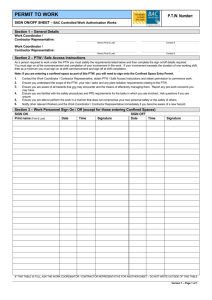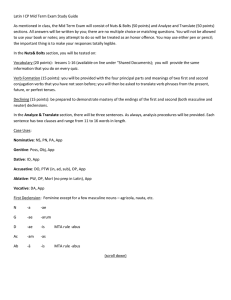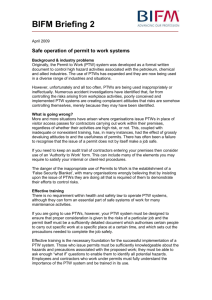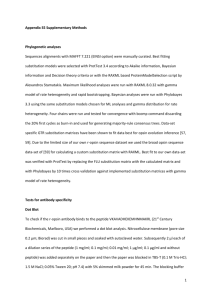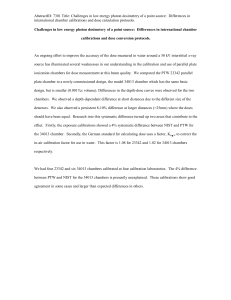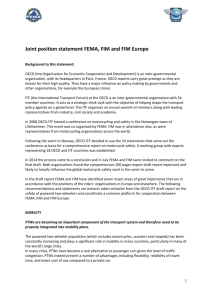Understanding the use of powered-two
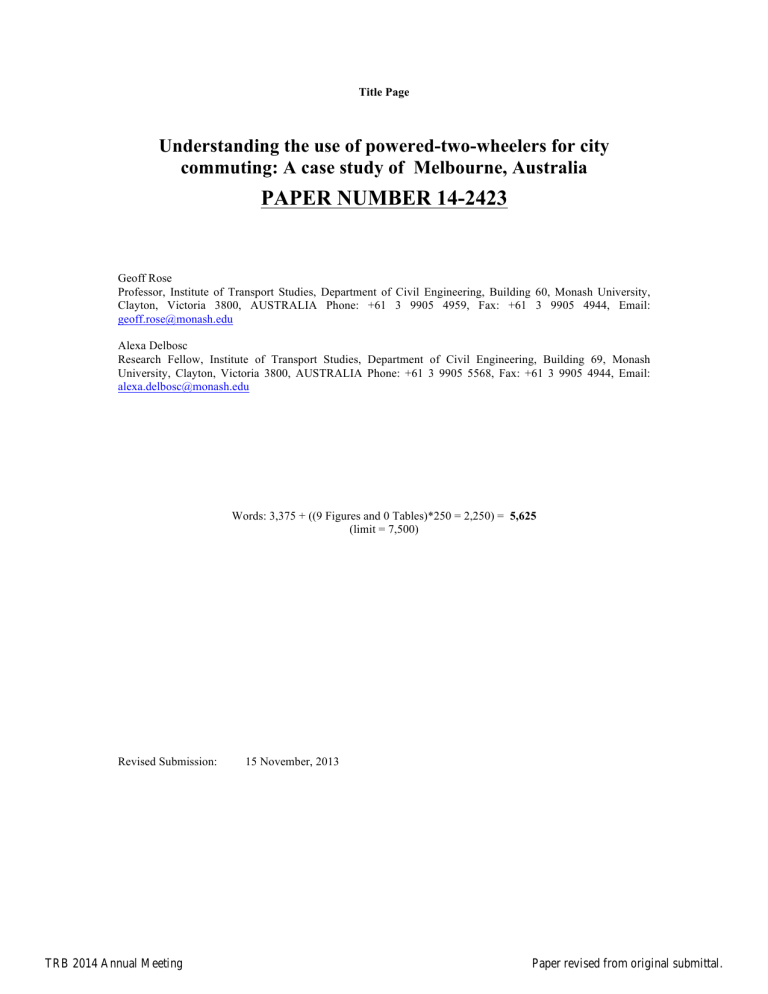
Title Page
Understanding the use of powered-two-wheelers for city commuting: A case study of Melbourne, Australia
PAPER NUMBER 14-2423
Geoff Rose
Professor, Institute of Transport Studies, Department of Civil Engineering, Building 60, Monash University,
Clayton, Victoria 3800, AUSTRALIA Phone: +61 3 9905 4959, Fax: +61 3 9905 4944, Email: geoff.rose@monash.edu
Alexa Delbosc
Research Fellow, Institute of Transport Studies, Department of Civil Engineering, Building 69, Monash
University, Clayton, Victoria 3800, AUSTRALIA Phone: +61 3 9905 5568, Fax: +61 3 9905 4944, Email: alexa.delbosc@monash.edu
Words: 3,375 + ((9 Figures and 0 Tables)*250 = 2,250) = 5,625
(limit = 7,500)
Revised Submission: 15 November, 2013
TRB 2014 Annual Meeting Paper revised from original submittal.
Rose and Delbosc
Abstract
Australia’s cities are facing increasing concerns over traffic congestion and pollution which has encouraged an interest in sustainable transport choices. Most of the focus of this concern has been on cars, public transport and active transport; in contrast, the role of powered two-wheelers (PTW, including motorcycles and scooters) in commuting has received relatively little attention. Little is known about who uses PTW for city-based commuting.
This paper presents the results of an intercept survey of PTW riders in the city centre of Melbourne in
September 2012. Some 346 riders responded to an intercept survey which recorded key demographics of PTW commuters, their trip origin and journey purpose, vehicle ownership, use of safety gear and reasons for PTW use. On average PTW commuters tend to be highly educated with high incomes. Sport bikes and conventional bikes were the most popular PTW vehicles; motor scooters were used more by women, short-distance commuters and higher-income earners. Safety gear was less likely to be used by women and motor scooter riders. Survey respondents highly valued the benefits of PTW commuting such as free parking in the city centre, travel time savings and parking near their destination.
TRB 2014 Annual Meeting Paper revised from original submittal.
Rose and Delbosc
INTRODUCTION
All round the world, governments face the challenge of responding to increasing problems of urban traffic congestion, death and injury from road crashes, vulnerability of energy sources and adverse environmental impacts such as poor local air quality and accelerating global climate change. These problems have been magnified because the motor vehicle is the predominant form of urban mobility [1]. As awareness of the importance of enhancing the sustainability of existing transport systems grows, policy-makers’ attention is turning to the broad range of both supply and demand oriented measures available to address these challenges.
In the context of sustainable mobility, the opportunities Powered Two Wheel vehicles present have not been investigated in detail [2]. The term Powered-Two (or Three)-Wheel (PTW) vehicle is being used cover a range of two or three wheel vehicles from mopeds (low power motor cycles typically with engines less than
50cc and usually with a maximum speed of 50 kph) to motor scooters and motorcycles [3]. Recent European research conducted in Belgium [4] and France [5] has highlighted the opportunities presented by PTW to reduce traffic congestion and emissions. The challenge from a policy perspective remains the over-representation of
PTW vehicles in crash statistics both in Australia and overseas [6-8]. Even after accounting for the costs of
PTW crashes, Kopp [5] found a net community gain from the increase in PTW use which has occurred in Paris.
However, he highlights the need for public policy measures that would decrease the number of PTW crashes.
In seeking to better understand the opportunities associated with PTW vehicles, as well as to better manage their shortcomings, enhanced understanding of the factors driving ownership and use is vital. A fundamental challenge faced by studies which have either sought to better understand the travel demand dimensions of the mode, or measure exposure to provide a stronger basis for road safety policy, is the historically low response rates to travel surveys which are sent to riders.
Of fundamental importance with any survey designed to understand PTW use is the response rate and the extent to which the responses which are received are representative of the target population. Wigan [9, pp.
44] notes the ‘problems of obtaining survey responses from motorcyclists’ and reports results from a survey conducted in Melbourne where a 15 % response rate was achieved. Similarly, Harrison and Christie [8] report a useable response rate of 13 % from a survey of motorcyclists they conducted in New South Wales. Jamson and
Chorlton [10] reported a response rate of 20 % in a survey of registered owners of motorcycles in the UK. Those response rates are less than half the roughly 50 % response obtained for the VISTA travel surveys in Melbourne
[11] and less than half the response rates achieved in general travel surveys internationally [12]. Low response rates, compounded by often modest total numbers of returned surveys, means that the extent to which the responses can be regarded as representative of the underlying population must be carefully assessed and the quantum of data often makes it difficult to gain insight into sub-group behaviour.
Thompson and Rose [13] sought to overcome some of the shortcomings of questionnaire surveys by exploring the insight into travel behaviour which could be obtained by undertaking a patrol survey of PTW parked in the Melbourne CDB and matching licence plate numbers to basic registration details. However the absence of any contact with the rider meant that no insight could be obtained about the trip purposes, factors influential in the decision to ride and socio-demographics of the riders.
The aim of the research reported here was to obtain deeper understanding of CBD PTW commuters in
Melbourne by undertaking an intercept and follow up survey. Survey questions explored the following topics:
•
Demographic characteristics of PTW commuters
•
Vehicle ownership of PTW commuters
• Use of safety gear
•
Reasons for PTW use
The structure of this paper is as follows. Section 2 explains the geographic context of the research. In
Section 3, the research method is described while the results are presented in Section 5. Conclusions and research directions are covered in Section 5.
RESEARCH CONTEXT
Melbourne’s city centre is serviced by a series of freeways, major arterials and rail lines (see Figure 1). In 2011, over 186,000 people worked in inner Melbourne; of those, 72% used public transport to travel to work, 22% drove or where driven to work, 5% walked, 3% rode a bicycle and 1% rode a motorbike or scooter [14].
Estimates range between 1,500 and 1,800 PTW commuters into the city centre, depending on the survey day and method [13, 14].
PTW riders have a somewhat unique situation amongst Melbourne commuters. They are exempt from paying the toll on the major tollway that services the northern, western and south-eastern suburbs. In addition,
TRB 2014 Annual Meeting Paper revised from original submittal.
Rose and Delbosc they do not have to pay for city parking, either using free motorcycle parking areas or legally parking on city footpaths.
The central city location was selected because it represents the highest density of PTW destinations in the metropolitan area. Given the time and effort devoted to the survey, the CBD location provided an opportunity to maximise the insight obtained into the travel behaviour of PTW commuters.
FIGURE 1: Survey Location.
RESEARCH METHOD
On 19 September 2012 a survey was conducted covering Melbourne’s central city grid (see Figure 1). Between
7:00 and 11:00, survey teams patrolled designated areas of the CBD where large concentrations of motorcyclists were known to park. Field staff were allocated to areas according to the PTW concentrations measured in a patrol survey conducted the year before [13]. Riders were approached as they parked their vehicles and invited to participate in the survey. The survey procedure was as follows:
1.
Riders were asked three quick questions and responses were recorded by the survey team.
2.
Respondents were invited to do longer a follow-on survey online, either by writing down their email address or being given a link to the survey
The three questions asked during the intercept survey were the purpose of the trip, the origin postcode where they began their journey that day, and what mode they would have used if they could not use their PTW that day. In addition, interviewers also noted the respondent’s gender, arrival time and license plate number.
The follow-on survey asked a broader range of questions including demographics, vehicle ownership and reasons for owning and using their PTW.
RESULTS
TRB 2014 Annual Meeting Paper revised from original submittal.
Rose and Delbosc
Response rate and sample size
Of the 440 riders approached, 346 answered the ‘three quick questions’ with a response rate of 79%. A further
122 people completed the follow-on survey, corresponding to a final response rate of 28%. As noted in the introduction, obtaining information from PTW riders is a challenge given the historically low response rates.
Given that response rates ranging from 13 to 20% are reported in the literature for PTW surveys [8-10], the response rate achieved here is better than that achieved in many other studies.
While the response rate itself is important, particularly when assessing the risk of non-response bias and representativeness of the responses, the absolute number of responses is also important. Small sample sizes make it difficult to conduct detailed analysis on subgroups. The Victorian Government undertook a special survey of PTW riders in 2007 as an adjunct to the general household travel survey undertaken in that state. The effective response rate on that special PTW survey was 21% [15]. That survey yielded information on a total of
129 people from not only Victoria’s capital city Melbourne, but also five regional cities (Greater Geelong,
Ballarat, Bendigo, Shepparton, LaTrobe) who reported riding their PTW over the 10 day survey period. The survey reported here captured basic information from 346 PTW riders and more in-depth information from 122.
In summary, the survey achieved a response rate well above that typically achieved in surveys of PTW riders and the number of responses provides insights into the travel behaviour of a larger sample of PTW riders than has been obtained from any survey in Victoria.
Respondent demographics
An important objective of the survey to understand who uses PTW to commute into the city centre. Some 91% of survey respondents were male, 70% had a graduate or post-graduate degree, almost 70% earned over $80,000 per annum and most were in their 30’s or 40s. Most respondents were living in a couple (43% with children,
34% without) compared to 12% who lived alone and 8% who lived with roommates.
Figure 2 compares the demographics of the survey sample to the demographics of all Melbourne city workers recorded during the 2011 census [14]. The demographics of the survey sample are largely a reflection of inner-city workers who tend to be highly educated, higher income and somewhat young. However the survey sample was even more likely to have a higher degree and earn a higher income; they were also slightly older than the average city worker.
FIGURE 2: Survey sample demographics compared to census of Melbourne CBD employees.
PTW and other vehicle ownership
The PTWs used by respondents were classified twice – interviewers classified the vehicles using their own judgment during the intercept survey and survey respondents classified their own vehicles during the follow-on survey. Around one-third of commuters used a scooter to commute into the city. Sport bikes and conventional bikes were also common although there was some discrepancy in classification between the intercept and
TRB 2014 Annual Meeting Paper revised from original submittal.
Rose and Delbosc follow-on surveys. Cruisers, trail bikes and other PTW types were less common. Women were far more likely to drive a motor scooter (70%) than men (33%).
FIGURE 3: Powered two-wheeler use for commuting to the CBD.
The classification provided in the follow-on survey was compared to household income in Figure 4. Lowerincome households were more likely to commute using traditional or sports bikes whereas higher-income households were more likely to use a motor scooter.
FIGURE 4: Powered two-wheeler use by income.
Figure 5 explores how PTW engine size is related to commute length. As engine size increases, average commute travel time and distance tends to increase. On average, the larger engine sizes (over 500cc) tend to commute around 25km into the city centre, compared to lowest capacity engines which commute fewer than
10km.
TRB 2014 Annual Meeting Paper revised from original submittal.
Rose and Delbosc
FIGURE 5: Commute travel time and distance by PTW engine size.
Follow-on survey respondents were asked to share how many vehicles they owned. Figure 6 shows that over
60% of survey respondents reporting owning 4 or more motorcycles, scooters and/or mopeds. Over 70% had two or more household cars and over half had a van or ute at home. Household bicycle ownership was high; over 60% of households had two or more bicycles.
FIGURE 6: Household vehicle ownership.
Furthermore, respondents were asked whether purchasing a PTW had an impact on the cars they owned. Some
9% did not previously own a car, 15% said they sold one or more cars when they purchased the PTW and 76% said that the PTW was purchased as an additional vehicle.
Use of safety gear
Survey respondents were asked about their ownership and use of safety gear including helmets, gloves, jacket, pants and boots. All respondents said they use a helmet and gloves when commuting into the city and 92% said they owned and wore a jacket. However the use of pants and boots was more variable. Figure 7 shows the variation in ownership and use of pants and boots by gender and PTW type. Over 60% of men and around 80% of those who drive sports or traditional bikes use safety pants and boots when travelling into the city.
Conversely, only around one third of women and motor scooter riders use these items of safety gear when driving into the city. Half of women and 35% of motor scooter riders do not even own appropriate pants and
22% of women / 42% of scooter riders do not own safety boots.
TRB 2014 Annual Meeting Paper revised from original submittal.
Rose and Delbosc
FIGURE 7: Ownership and use of safety gear by gender and PTW type.
Powered two-wheeler use
The PTW were predominantly used for work trips (96%) with less than one per cent of the trips for accessing education and the remainder for social/recreation.
During the intercept survey, people were asked what mode they would have used to travel that day if their PTW had not been available. Nearly 70% of respondents said they would have taken public transport; the next-highest modes were driving a car (14%), bicycle (7%), would not travel (4%), walk (3%) or a combination of modes (4%).
In the follow-on survey, respondents were asked what factors influenced their decision to use a PTW to commute into the city. Responses are shown in Figure 8. The most important reasons rated by respondents reflected the flexibility and low cost of PTW commuting: free parking, choosing when to travel, saving time and parking near their destination. Less important were lifestyle factors, more general purchase/maintenance costs or environmental impacts.
TRB 2014 Annual Meeting
FIGURE 8: Reasons use PTW to commute into city.
Paper revised from original submittal.
Rose and Delbosc
Respondents were also asked about reasons for choosing a PTW on a day-to-day basis. Figure 9 shows that before/after work commitments and heavy rain had the largest impact on day-to-day use, followed by needing to carry items and strong wind.
FIGURE 9: Reasons use PTW on a day-to-day basis.
DISCUSSION AND IMPLICATIONS
This paper presents some of the first in-depth information about people who use PTWs to commute into a CBD.
Although this is only a single-day survey, the overall response rate (28%) was high by industry standards.
PTW city commuters tended to be highly educated with high incomes, even compared to the average city worker. They were predominantly male and most lived with a partner. Sport bikes, conventional bikes and motor scooters were all popular; motor scooters were used more often by women and higher-income earners.
Researchers are beginning to explore the opportunity for PTWs to reduce traffic congestion and environmental emissions [4, 5] . However this questions the extent to which PTW commuters are contributing to these goals. Most PTW-riders live in households with multiple PTWs and cars and 76% did not sell their car when they purchased their PTW. Furthermore the PTW does not appear to be replacing car commute trips as only 14% said they would have driven a car if their PTW was not working (adding approximately 220-250 cars to the daily commute of over 39,000). However PTW users may play a greater role in easing the overcrowding that occurs on peak-hour public transport into the city. Some 67% of PTW commuters (approximately 1,050-
1,200 people) would have otherwise taken public transport into the city. That many commuters would almost fill one peak-hour train.
Survey respondents highly valued the utilitarian benefits of PTW commuting such as free parking, travel time savings and parking near their destination. These decisions are supported by significant benefits in
Melbourne (e.g. no freeway toll, free parking on sidewalks). Research such as this highlight the importance of weighing these benefits to the commuter against wider societal benefits (e.g. relieving pressure on public transport) and disbenefits (e.g. foregone revenue, road safety impacts).
This survey focused on commuters in Melbourne’s city centre. This represents only one part of the market; in future, surveys targeting riders travelling to other destinations will be important to broaden the understanding of PTW ownership and use.
ACKNOWLEDGMENTS
This research was supported under the Australian Research Council’s Linkage Projects funding scheme (Project
LP100200197) and conducted in conjunction with VicRoads, the Victorian Department of Transport, the
Transport Accident Commission, the Royal Automobile Club of Victoria and the Federal Chamber of
Automotive Industries. The views expressed herein are those of the authors and are not necessarily those of the
Australian Research Council or any of the organizations associated with the project.
We gratefully acknowledge the assistance of students enrolled in CIV4283 Transport Planning in
Semester 2, 2012. The students in that class were responsible for undertaking the survey as part of a class project and their willingness to support the wider research project is greatly appreciated.
TRB 2014 Annual Meeting Paper revised from original submittal.
Rose and Delbosc
LIST OF FIGURES
FIGURE 1: Survey Location.
FIGURE 2: Survey sample demographics compared to census of Melbourne CBD employees.
FIGURE 3: Powered two-wheeler use for commuting to the CBD.
FIGURE 4: Powered two-wheeler use by income.
FIGURE 5: Commute travel time and distance by PTW engine size.
FIGURE 6: Household vehicle ownership.
FIGURE 7: Ownership and use of safety gear by gender and PTW type.
FIGURE 8: Reasons use PTW to commute into city.
FIGURE 9: Reasons use PTW on a day-to-day basis.
REFERENCES
1. Sperling, D. and D. Gordon,
University Press.
Two billion cars: driving toward sustainability . 2010, Oxford: Oxford
2. Rose, G., Motorcycles: a growing dot on the transport policy radar , in 32nd Australasian Transport
Research Forum . 2009: Auckland, NZ.
3.
4.
5.
6.
Victorian Government, Victoria’s Road Safety and Transport Strategic Action Plan for Powered Two
Wheelers 2009-2013 . 2009: Victoria, Australia. p. 41.
Yperman, I., Commuting by motorcycle: impact analysis . 2011, Transport & Mobility Leuven.
Kopp, P., The unpredicted rise of motorcycles: A cost benefit analysis.
Transport Policy, 2011. 18 (4): p. 613-622.
Christie, R., Investigating of Motorcycle Crash Patterns for Riders Aged 17-25 in NSW and
Development of Countermeasure Strategies (Supplementary Analysis in Respect of Motorcycle Type,
Make & Model) . 2002, Motor Accidents Authority of NSW.
7.
8.
9.
10.
11.
12.
13.
14.
15.
Christie, R. and W.A. Harrison, Investigating of Motorcycle Crash Patterns for Riders Aged 17-25 in
NSW and Development of Countermeasure Strategies . 2001, Motor Accidents Authority of NSW.
Harrison, W.A. and R. Christie, Exposure survey of motorcyclists in New South Wales.
Accident
Analysis & Prevention, 2005. 37 (3): p. 441-451.
Wigan, M., Motorcycles as a full mode of transportation.
Transportation Research Record, 2002. 1818 : p. 39-46.
Jamson, S. and K. Chorlton, The changing nature of motorcycling: Patterns of use and rider characteristics.
Transportation Research Part F: Traffic Psychology and Behaviour, 2009. 12 (4): p.
335-346.
Department of Transport, Victorian integrated survey of travel and activity (VISTA) 2007 . 2009.
Ortúzar, J.D.D., et al., Continuous Mobility Surveys: The State of Practice.
Transport Reviews, 2010.
31 (3): p. 293-312.
Thompson, R.G. and G. Rose, Understanding the use of powered two wheelers within an Australian capital city: The case of Melbourne's central business district , in Transportation Research Board 92nd
Annual Meeting . 2013: Washington DC.
Australian Bureau of Statistics, Working population profile based on place of work, Melbourne . 2011.
Amani, B., G. Rose, and R.G. Thompson, Motorcycle and Motor Scooter Use in Victoria, Australia , in
Transportation Research Board 92nd Annual Meeting . 2013: Washington DC.
TRB 2014 Annual Meeting Paper revised from original submittal.
